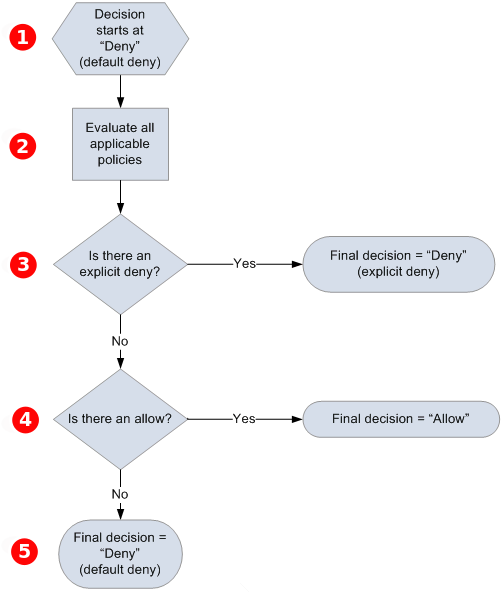Amazon SQS Access Policy Language evaluation logic
At evaluation time, Amazon SQS determines whether a request from someone other than the resource owner should be allowed or denied. The evaluation logic follows several basic rules:
-
By default, all requests to use your resource coming from anyone but you are denied.
-
An Allow overrides any Default-deny.
-
An Explicit-deny overrides any allow.
-
The order in which the policies are evaluated isn't important.
The following diagram describes in detail how Amazon SQS evaluates decisions about access permissions.

 The decision starts with a default-deny.
The decision starts with a default-deny.
 The enforcement code evaluates all the policies that are
applicable to the request (based on the resource, principal, action, and
conditions). The order in which the enforcement code evaluates the policies
isn't important.
The enforcement code evaluates all the policies that are
applicable to the request (based on the resource, principal, action, and
conditions). The order in which the enforcement code evaluates the policies
isn't important.
 The enforcement code looks for an explicit-deny instruction that can apply to the request. If it
finds even one, the enforcement code returns a decision of deny and the process finishes.
The enforcement code looks for an explicit-deny instruction that can apply to the request. If it
finds even one, the enforcement code returns a decision of deny and the process finishes.
 If no explicit-deny
instruction is found, the enforcement code looks for any allow instructions that can apply to the request. If it finds
even one, the enforcement code returns a decision of allow and the process finishes (the service continues to process
the request).
If no explicit-deny
instruction is found, the enforcement code looks for any allow instructions that can apply to the request. If it finds
even one, the enforcement code returns a decision of allow and the process finishes (the service continues to process
the request).
 If no allow instruction is
found, then the final decision is deny (because
there is no explicit-deny or allow, this is considered a default-deny).
If no allow instruction is
found, then the final decision is deny (because
there is no explicit-deny or allow, this is considered a default-deny).